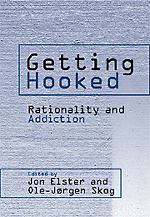Book contents
- Frontmatter
- Contents
- Preface and Acknowledgments
- Contributors
- Introduction
- Addiction and Social Interaction
- Addiction, Weakness of the Will, and Relapse
- The Dangers of Willpower
- The Neurobiology of Chemical Addiction
- To Legalize or Not to Legalize: Is That the Question?
- Rationality, Irrationality, and Addiction – Notes on Becker's and Murphy's Theory of Addiction
- Gambling and Addiction
- A Visceral Account of Addiction
- Epilogue: Rationally Coping with Lapses from Rationality
- Index
Addiction and Social Interaction
Published online by Cambridge University Press: 05 June 2012
- Frontmatter
- Contents
- Preface and Acknowledgments
- Contributors
- Introduction
- Addiction and Social Interaction
- Addiction, Weakness of the Will, and Relapse
- The Dangers of Willpower
- The Neurobiology of Chemical Addiction
- To Legalize or Not to Legalize: Is That the Question?
- Rationality, Irrationality, and Addiction – Notes on Becker's and Murphy's Theory of Addiction
- Gambling and Addiction
- A Visceral Account of Addiction
- Epilogue: Rationally Coping with Lapses from Rationality
- Index
Summary
Introduction
Many forms of drug use and drug abuse are clearly social in character. Heavy consumption is allowed in some social situations and banned in others. Collective intoxication may sometimes signal friendship and virility, while outsiders may be offended by the abuse. Drug use is also affected by geographic and ethnic belongings where values and rewards of drug use seem to be inherited from previous generations. Most societies differ, for example, in drinking customs. Citizens who are members of several small societies within their community seem to drink differently within each. Use of narcotics is often initiated by friends, gang members, or neighborhood acquaintances, and habits may change once gang membership is abandoned. Some subgroups or cults develop legal and illegal drug ceremonies that resemble religious drug use in more primitive societies. (Encyclopedia Britainica)
These social characteristics of drug use do not contradict the fact that people may rationally choose their way of living. People may act rationally, but not necessarily within social circumstances chosen by themselves. In the theory of rational addiction, however, the focus is on how one person may develop addictive behaviors in situations from which interaction between potential drug users can be abstracted (Becker and Murphy [1988], Orphanides and Zervos [1992], and others). As a contrast to these rational addiction models, this paper focuses on long-range equilibria of social interaction within a group of persons and neglects addictive dynamics within each person separately.
- Type
- Chapter
- Information
- Getting HookedRationality and Addiction, pp. 30 - 46Publisher: Cambridge University PressPrint publication year: 1999
- 3
- Cited by



